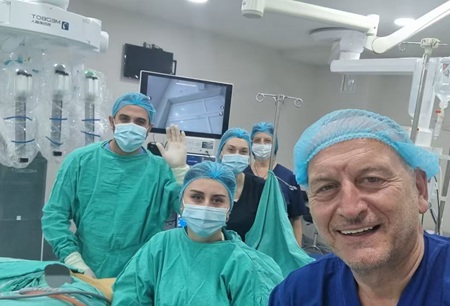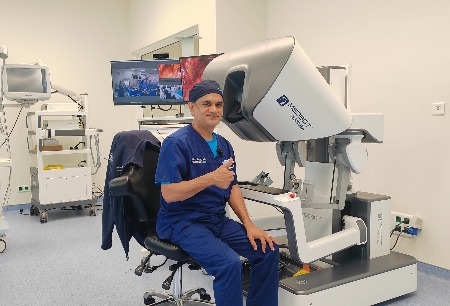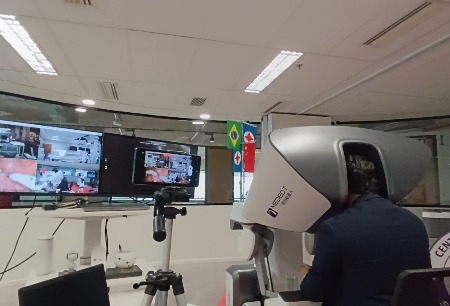Zhengzhou, China - On April 26, Toumai® four-arm laparoscopic surgical robot (Toumai® Robot) of Shanghai MicroPort MedBot (Group) Co., Ltd. (MicroPort® MedBot®) successfully completed a robot-assisted radical kidney cancer surgery combined with inferior vena cava embolization at the First Affiliated Hospital of Zhengzhou University (the First Affiliated Hospital of ZZU). It is worth remembering that it is also the first case of Chinese-developed robot applied to such difficult surgeries, means that Chinese-developed robot-assisted urological micro-trauma surgery has reached a new milestone.
The surgery was performed by the team of Professor Xuepei Zhang in the Department of Urology of the First Affiliated Hospital of ZZU. Featured by high risk, large amount of blood loss and great challenge to the surgeon, such surgeries are known as the "crown jewel" of urological surgery. The successful response to this challenge by the surgeon with the assistance of Toumai® Robot is a testament to the professional strength of Professor Xuepei Zhang and the reliable, stable assistance of the Chinese-developed Toumai® Robot.
Difficult surgery is like "Disabling Explosives" in the body, requiring double "hard power" of the surgeon + robot
Like an unscheduled bomb in the body, kidney cancer with inferior vena cava thrombosis is a high-risk disease that endangers patients' lives. Nearly 5% of patients with kidney cancer have vena cava tumor thrombosis, and the median survival of renal cancer sufferers with inferior vena cava tumor thrombosis without surgery is only 6.9 months. Surgical treatment can obviously improve their prognosis. The 5-year specific survival rate after radical nephrectomy + vena cava tumor thrombectomy is 57%-69%. Therefore, renal cancer sufferers with vena cava thrombosis should be actively treated surgicallyprovided that there is no contraindication.
Radical resection of renal cancer combined with inferior vena cava embolization is a very difficult procedure. In addition to removing the kidney affected by cancer, it is also required to temporarily block the vena cava flow and perform a difficult operation to remove the cancerous clot and suture the vena cava incision in a very short period of time. Many difficulties will be encountered during the procedure, such as the risk of hemorrhage during inferior vena cava dissection for embolization, abnormal intra-abdominal anatomy due to large renal tumors, adequate dissection of the cancer embolus, and the risk of dislodgement during the procedure. Improper management of these intraoperative problems may cause serious complications and even endanger the patient's life, so the surgeon is required to have high surgical skills and strong psychological qualities and the robot is required to be highly compatible and stable in performance.
Chinese-developed Toumai® empowers surgical treatment, giving patients more "medical" reliance
Limited by technical conditions, traditional open surgical treatment features high intraoperative bleeding, extensive trauma, and more postoperative complications, and even a mortality rate of 5%-10%. Robot-assisted precise freeing and positioning allows for blocking the inferior vena cava and thus reducing patient trauma and risk to some extent. In view of the patient's complex condition and high surgical risk, Professor Xuepei Zhang's team decided to use the Chinese-developed Toumai® Robot in the operation after detailed, thorough preoperative preparation and surgical procedures.
Patient information:
The patient was a female, 51 years old. She developed lumbar pain with no obvious cause 20 days ago, with persistent distension, accompanied by weakness, nausea and vomiting, without accompanying symptoms such as chest tightness, shortness of breath, painful urination, blood in urine, frequent urination, and low fever. CT examination suggested a malignant occupancy in the lower pole of the right kidney with right renal vein and inferior vena cava embolus (Mayo grade II); clear cell carcinoma was considered to be more likely.
Procedure:
Intraoperatively, perinephric and inferior vena cava adhesions were seen, and the extrusion of the renal tumor changed the normal anatomical structure, greatly increasing the difficulty of surgery. The high-definition immersive 3D field of view and the sensitive, easy-to-use high-freedom wrist robot arm of the Toumai® Robot assisted Professor Xuepei Zhang in identifying the surrounding kidney tissues and completing the removal of kidney tumors and the exposure of large blood vessels, followed by blocking the distal end of the inferior vena cava, the contralateral renal vein, and the proximal end of the inferior vena cava in turn, quickly incising the inferior vena cava, freeing the cancer embolus and removing it with care, and then successively suturing the inferior vena cava incision. The whole operation was a success.
Xuepei Zhang, professor of the First Affiliated Hospital of ZZU, said that the operation was full of risk, placing high demands on both the surgeon and the robot, and the operation showed that Toumai® Robot was able to provide smooth assistance throughout the process. He also expected that the Chinese-developed robot will continue to make more breakthroughs to surpass itself, and keep strengthening its technical strength for the benefit of Chinese patients.
Mr. Yu Liu, Executive Group Vice President and Chief Commercial Officer of MicroPort® MedBot said, "We truly appreciate Director Xuepei Zhang and the First Affiliated Hospital of ZZU for trusting and recognizing Toumai® Robot. Our aim is to provide solutions by keeping challenging for more new, difficult surgical procedures, to break the technical bottleneck of Chinese-developed robots, to improve clinical adaptability, to bring health and hope to more patients, and to achieve our original intention to "Make Surgery Easier, Safer and Less Invasive"."
-
 2024-11-18Karazanashvili Robotic Center Completed 100 Toumai® Robot-Assisted Surgeries, becoming the Only Robotic Surgery Center in the Caucasus Region
2024-11-18Karazanashvili Robotic Center Completed 100 Toumai® Robot-Assisted Surgeries, becoming the Only Robotic Surgery Center in the Caucasus Region -
 2024-10-26TOUMAI® SURGICAL ROBOT SYSTEM COMPLETES MULTIPLE LANDMARK ROBOTIC TELESURGERY CASES IN SUB-SAHARA AFRICA IN THE REPUBLIC OF ANGOLA
2024-10-26TOUMAI® SURGICAL ROBOT SYSTEM COMPLETES MULTIPLE LANDMARK ROBOTIC TELESURGERY CASES IN SUB-SAHARA AFRICA IN THE REPUBLIC OF ANGOLA -
 2024-10-26Toumai® Achieves South America's First Tele-Surgery Demonstration
2024-10-26Toumai® Achieves South America's First Tele-Surgery Demonstration






 Hu ICP Bei No. 20013662 HGWA Bei No. 31011502015178
Hu ICP Bei No. 20013662 HGWA Bei No. 31011502015178 " are registered trademarks of Shanghai MicroPort Medical (Group) Co., Ltd.” . They have been authorized to be used by Shanghai Microport Medbot (Group) Co., Ltd., and no other party shall use such trademarks without prior written permission thereof.
" are registered trademarks of Shanghai MicroPort Medical (Group) Co., Ltd.” . They have been authorized to be used by Shanghai Microport Medbot (Group) Co., Ltd., and no other party shall use such trademarks without prior written permission thereof.
